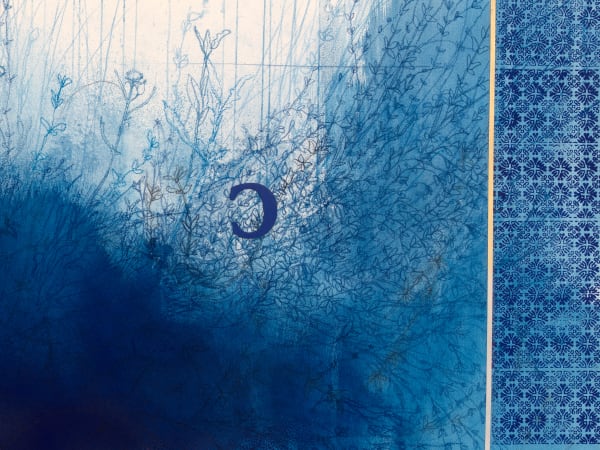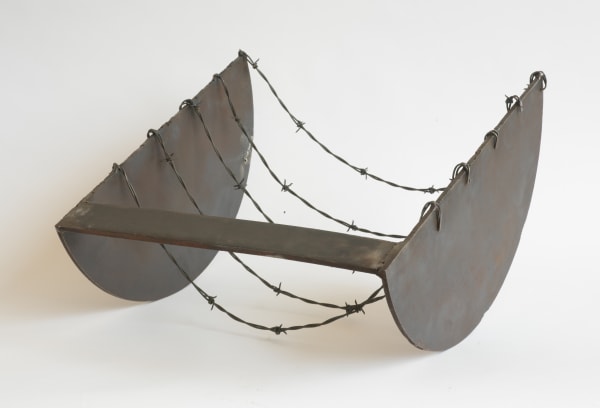Frieze London 2024 | Booth C15
Preview (invitation-only): October 9–10, 2024
Public Days: October 11–13, 2024
The Regent’s Park, NW1 4LL
Alexander Gray Associates presents recent and historical works by Chloë Bass, Frank Bowling, Ricardo Brey, Bethany Collins, Melvin Edwards, Harmony Hammond, Kang Seung Lee, Steve Locke, Carrie Moyer, Ronny Quevedo, Joan Semmel, Hugh Steers, and Ruby Sky Stiler. Breaking new formal and conceptual ground, these artists’ distinct practices are united by their innovative approaches to materiality and representation.
For more than half a century, Frank Bowling has imbued abstraction with personal and collective memory to reflect on Black identity. Continually refining his use of color, paintings like Sunrise (2020) evoke the luminosity of eighteenth-century English landscape painting while recalling the shimmering haze of waterways in the artist’s native Guyana. A longtime friend of Bowling, Melvin Edwards constructs abstract sculptures that meld expressivity with modernist forms. Works like Combination (2005)—a part of the artist’s ongoing series of Lynch Fragments—use steel to allude to both physical labor and racial violence, reconfiguring narratives around the African Diaspora.
Meanwhile, Chloë Bass examines the potential of language. Chronicling the upheavals structuring everyday life, Bass’s January 6th – 7th, 2020 (2024) consists of a pair of lamps inscribed with the artist’s account of the days’ happenings. Subtle shifts in the lamps’ intensity mark the passage of time—instigating, per Bass, new modes of “seeing.” Contradistinct to Bass’s approach, Bethany Collins utilizes paper’s material qualities, its reactions to physical events, to encode broader histories. With Old Ship XII (2023), Collins molds paper into a monument to Black American history.
By contrast, both Joan Semmel and Carrie Moyer embrace bold approaches to color and form. Since the 1970s, Semmel has intervened within the art historical tradition of the nude. Canvases like Seated (2024) celebrate color and flesh, taking the artist’s own body as their subject. Moyer’s playful compositions similarly emphasize the sensorial. In Icy Hot (2024), she crafts an immersive, tactile surface suggestive of the natural world. By the same token, Ricardo Brey’s commitment to color—evinced in his ongoing series of blue works including Filtering of Lights (2023)—intertwines the history of the monochrome with landscape.
Equally invested in the juxtaposition of form and content, Harmony Hammond and Ruby Sky Stiler reframe painting through queer and feminist lenses. Hammond’s near-monochromatic paintings like Lace II (2013) boast heavily worked, skin-like surfaces. Queering the modernist monochrome, these canvases champion an approach to abstraction rooted in the body. Like Hammond, Stiler’s relief paintings challenge art historical archetypes. Works such as Seated Blue Figure (with turquoise and red outline)(2024) present collaged female figures against fractal-like grounds to combat the dichotomy between, in Stiler’s words, “woman as subject of painting versus creator of image.” In turn, Ronny Quevedo’s multilayered drawings like el centro folklórico (2024) fragment and reassemble the abstract motifs of Pre-Columbian textiles. Collapsing distinctions between past and present, for Quevedo, these works “give life to an ancestry of abstraction and transformational figures.”
In contrast, Steve Locke’s cruisers paintings like cruisers (lunch counter) (2024) use figuration to capture intimate moments between men. These compositions emerge as meditations on the gaze, mapping the politics—and dangers—of desire. Also capturing the perils of desire, Hugh Steers’s Shadow Box (1991) illustrates the unsettling psychic realities of queer men navigating a world indelibly altered by the AIDS epidemic. Finally, Kang Seung Lee recontextualizes visual materials connected to queer history and collective memory. In Untitled (Elysian 2) (2024), Lee reproduces seed pods and dried flowers gathered from Elysian Park, a famous queer cruising site in LA. By memorializing this flora, Lee explains he “[creates] this space for bodily experience … through artistic labor that cannot easily be put into words.”
Uniting divergent approaches to abstraction and representation, the Gallery’s presentation foregrounds these thirteen artists’ expansive modes of working. Together, the works on view underscore Lee’s belief that by “connecting different geographies and experiences … there is a possibility of creating new knowledge in [the] process.”





















